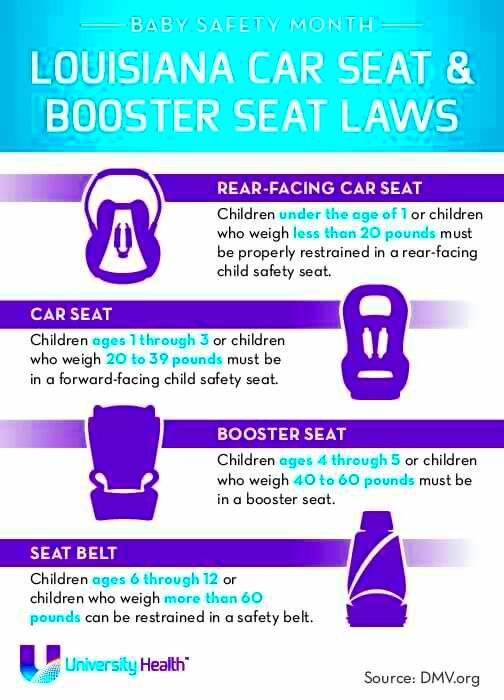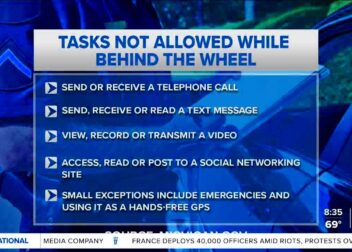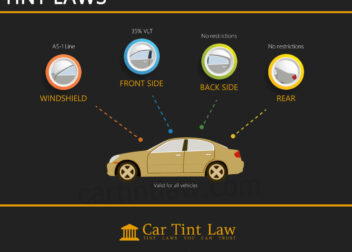Louisiana’s Child Restraint Safety Laws Explained
In Louisiana the safety of our children on the road is no joke. The child restraint laws here are all about making sure kids are buckled up snugly in cars. This goes a long way in keeping them safe and sound during accidents. Being a parent I totally get the never ending concern of keeping your little ones safe while on the move. These laws are pretty simple and to the point with the goal of safeguarding our most cherished passengers.
In Louisiana there are laws in place regarding the use of child safety seats. Kids are required to be secured in a seat until they hit a certain age, weight or height. These rules are more than just guidelines; they reflect a community’s dedication to keeping children safe. Each stage of a childs development comes with safety seat requirements that adjust to their evolving needs.
Requirements for Different Age Groups
It’s essential to grasp the specific requirements for different age groups to ensure adherence to regulations and, most importantly, safeguard your child’s well being. Here’s a summary of the key points you should be aware of.
- Infants (up to 2 years old): Infants must be in a rear-facing car seat. This position offers the best protection for their delicate neck and spine in the event of a crash.
- Children aged 2 to 4: Once your child outgrows the rear-facing seat, they should transition to a forward-facing seat with a harness. This harness should be used until they reach the maximum height or weight limit of the seat.
- Children aged 4 to 9: After outgrowing the forward-facing seat, your child should use a booster seat. This helps position the seat belt correctly across their body, providing better protection.
- Children aged 9 and above: Once they outgrow the booster seat, they can use the regular seat belt. However, the seat belt must fit correctly across their lap and shoulder.
These guidelines tailored to different age groups make sure that as your little one gets older their safety measures adjust to suit their growth and development. I remember feeling reassured when my kid was snugly buckled up in the appropriate car seat for their age it brought me comfort on every trip we took together.
Types of Child Restraints Approved in Louisiana
In Louisiana the kind of child restraint you choose has to adhere to certain safety regulations. Lets take a closer look at the car seat options that are sanctioned by the state.
- Rear-Facing Car Seats: These seats are designed for infants and toddlers up to the age of 2. They must be installed in the rear seat of the vehicle and face backward. These seats provide the best protection for young children in case of an accident.
- Forward-Facing Car Seats: Once your child outgrows the rear-facing seat, they transition to a forward-facing car seat with a harness. These seats should have a 5-point harness system and are suitable for children until they reach the seat’s weight or height limits.
- Booster Seats: Designed for children who have outgrown the forward-facing seat but are not yet tall enough for the seat belt to fit properly. Booster seats help position the seat belt correctly across the child’s chest and lap.
- Convertible Car Seats: These versatile seats can be used both rear-facing and forward-facing, making them a flexible option for growing children. They are a good investment as they can adapt to your child’s changing needs.
Every seat type is essential for keeping our kids safe. I’ve discovered that getting a top notch, flexible car seat offers my child a blend of comfort and protection making journeys feel a little less stressful.
Penalties for Non-Compliance
In Louisiana failing to adhere to child restraint laws can lead to repercussions. These penalties go beyond mere fines; they underscore the significance of keeping children safe while traveling in vehicles. I recall the uneasiness I experienced when a friend received a fine due to a oversight in car seat rules. It was a wake up call regarding the importance of these regulations for the welfare of our kids.
Heres a breakdown of the penalties you should be aware of.
- Fines: If you’re caught not using the proper child restraint, you could face fines ranging from $100 to $500. These fines can vary depending on the severity of the violation and whether it’s a repeat offense.
- Points on Driving Record: Violations can also result in points being added to your driving record. Accumulating too many points can lead to increased insurance premiums and even a potential suspension of your driving license.
- Required Educational Classes: In some cases, offenders may be required to attend educational classes about child safety and proper car seat use. These classes are designed to educate parents and caregivers on the importance of compliance.
These consequences act as an incentive to make sure we follow the rules. I recall feeling a sense of comfort after ensuring that my child’s car seat was securely in place. It gave me peace of mind knowing I had one less concern while driving. It may seem like a task but it greatly enhances the safety of our kids.
Exceptions to the Child Restraint Laws
Although Louisiana has laws regarding child restraints there are some notable exceptions worth noting. These exceptions can prove to be significant in certain situations and being aware of them can assist you in handling challenging scenarios more efficiently. As a parent I found it beneficial to be familiar with these exceptions to make choices regarding my childs well being.
- Medical Exemptions: If a child has a medical condition that makes it impossible to use a standard car seat, a doctor’s note can exempt them from the usual requirements. This ensures that children with special needs are not at a disadvantage.
- Emergency Situations: There may be cases where the use of a child restraint isn’t feasible due to an emergency situation. However, it’s important to note that these are exceptional cases and should be documented if possible.
- Interstate Travel: When traveling out of state, different regulations may apply. Louisiana generally honors child restraint laws from other states if they are at least as strict as Louisiana’s laws. However, it’s always a good idea to check the specific laws of the state you’re visiting.
Being aware of these exceptions can help you avoid unnecessary stress and ensure that you are following the law while also taking into account any specific situations. Personally I found that knowing about these exceptions made me feel more ready and self assured when traveling with my child.
How to Properly Install and Use Child Restraints
Properly installing and using child restraints isn’t just about following the law; it’s crucial for keeping your child safe. I remember the first time I put in a car seat; it was a bit daunting but making the effort to get it right really paid off. Here’s a helpful guide to make sure you’re doing it the way.
- Read the Manual: Always start by reading the car seat’s manual and your vehicle’s owner’s manual. Each seat and car may have specific instructions that are crucial for proper installation.
- Check the Seat Angle: Ensure that the car seat is at the correct angle. Most rear-facing seats have an angle indicator to help you achieve the right position. This helps protect your child’s head and neck.
- Secure the Car Seat: Use either the seat belt or the LATCH (Lower Anchors and Tethers for Children) system to secure the car seat. The seat should not move more than an inch side-to-side or front-to-back when properly installed.
- Adjust the Harness: The harness should be snug, with no more than one finger’s width between the harness strap and your child’s shoulder. For rear-facing seats, the straps should be at or below the child’s shoulders; for forward-facing seats, the straps should be at or above the shoulders.
By following these precautions you can make sure that your childs car seat is secure and cozy. Based on my own experience verifying the setup and ensuring the seat is a snug fit can be crucial during emergencies. Its definitely worthwhile to go the extra mile to keep your little one safe and sound, on every trip.
Resources for Parents and Caregivers
Staying updated on child safety seat laws can be challenging, but there are plenty of resources out there to assist parents and guardians in understanding these rules. I recall feeling confused when I first came across these regulations but discovering the right information sources really helped me out. Here’s a list of helpful tools and websites to check out.
- Local Health Departments: Many local health departments offer car seat safety checks and educational programs. They provide hands-on assistance and can ensure your car seat is installed correctly.
- Certified Child Passenger Safety Technicians: These professionals are trained to help you with car seat installation and offer advice tailored to your specific needs. Their expertise can be invaluable, especially for first-time parents.
- Online Resources: Websites like the National Highway Traffic Safety Administration (NHTSA) provide detailed guides and videos on car seat installation. These resources are often updated with the latest safety information.
- Community Organizations: Many community organizations and non-profits offer free car seats and safety education to families in need. They can be a great support, especially if you’re struggling to afford a new seat.
By using these resources you can stay updated and make sure that your childs car seat meets the latest safety standards. I discovered that contacting organizations not only offered assistance but also introduced me to a community of parents who had similar worries.
Updates and Recent Changes in the Law
Child seat laws aren’t set in stone; they change as new safety studies and tech progress. It’s essential to stay informed about these updates to make sure you’re following the rules. I remember how challenging it was to keep up with the latest guidelines, but staying updated is vital for your little ones well being.
- Recent Legislative Changes: Louisiana periodically updates its child restraint laws to align with current safety standards. For instance, recent updates might include changes in the age or weight requirements for transitioning between different types of car seats.
- Enhanced Safety Standards: New safety research may lead to stricter standards for car seats, including improved materials and design features. Keeping abreast of these changes ensures you’re using the safest available equipment.
- Periodic Reviews: Regularly check official sources like the Louisiana Department of Public Safety or the NHTSA for updates. These organizations provide timely information about any changes in laws and regulations.
Staying ahead of the game when it comes to learning about these updates can help you avoid accidentally falling out of compliance. Personally I always found comfort in being aware of the latest guidelines as it brought me peace of mind knowing that my child was as safe as possible.
FAQ
Grasping the intricacies of laws regarding child restraints can be quite perplexing. Below are some commonly asked questions that parents often have including those I found myself contemplating.
- What if my child falls asleep in the car seat? It’s common for children to fall asleep in their car seats, but it’s important that the seat remains properly adjusted. Ensure that the harness is snug and that the seat is in the correct position to maintain safety.
- Can I use a car seat that’s been in an accident? It’s generally recommended to replace any car seat that has been involved in a crash, even if it appears undamaged. The impact might compromise the seat’s integrity, so it’s safer to get a new one.
- When should I transition from a rear-facing to a forward-facing seat? Follow the car seat manufacturer’s recommendations regarding weight and height limits. Typically, it’s safest to keep your child rear-facing as long as possible before switching to a forward-facing seat.
- Are there any special considerations for tall or heavy children? Yes, some children might outgrow their car seats based on height or weight before reaching the age milestones. Check the car seat’s specifications and adjust accordingly to ensure a proper fit.
By tackling these inquiries you can shed light on any doubts you might be harboring. Personally I discovered that having responses to these frequently asked questions boosted my confidence in my decisions and assured me that I was adhering to the protocols for my childs well being.
Conclusion
To sum up Louisianas laws on child restraints are in place to keep our young travelers safe by making sure they are properly secured in vehicles. Its important for parents and caregivers to understand and follow these regulations. This includes knowing the appropriate restraints for different age groups and staying informed about any changes in the law. Being knowledgeable about these guidelines allows us to ensure the safety of our children. Personally I have found that following these rules not only helps us with the law but also gives me peace of mind, during every journey. By staying updated and using resources we can make every trip safer for our kids.


